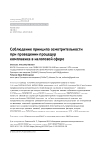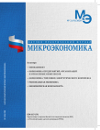Architectonics of economic security from the position of the formation of a modern censorship system
DOI: 10.33917/mic-2.121.2025.47-56
The article examines the historical features of the development of censorship as a system of restrictions and an element of ensuring socio-economic security. The mechanisms of censorship in different epochs of the formation of the world are analyzed. The ways of solving problems in the information environment using technologies in the modern world are outlined.
References:
1. Censorship. The Great Russian Encyclopedia. URL: https://old.bigenc.ru/domestic_history/text/4674643
2. Markin A.N. Institute of Censorship in the Roman Republic. URL: https://cyberleninka.ru/article/n/institut-tsenzury-v-rimskoy-respublike/
3. Surovtseva E.V. Censorship in Ancient Rus’. URL: https://cyberleninka.ru/article/n/tsenzura-v-drevney-rusi/
4. Kulikova S.A. Formation of the constitutional principle of inadmissibility of censorship in the Russian Federation. URL: https://cyberleninka.ru/article/
5. Constitution of the Russian Federation: The Constitution was adopted by popular vote on 12.12.1993 with amendments approved during the all-Russian vote on 01.07.2020. Access from the reference and legal system «ConsultantPlus».
6. On the media: Law of the Russian Federation of 27.12.1991 No. 2124-1 (as amended on 11.03.2024). Access from the reference and legal system «ConsultantPlus».
7. VTsIOM. URL: https://wciom.ru/analytical-reviews/
8. Valkova Irina. Blocking of Internet services in Russia in 2024: trends and reasons. URL: https://pronedra.ru/blokirovki-internet-servisov-v-rossii-v-2024
9. Roskomnadzor announced the existence of tools for “motivating” YouTube. URL: https://www.rbc.ru/technology_and_media/26/07/2024/
10. Peskov spoke in favor of complete freedom of information, but not in wartime. URL: https://tass.ru/politika/
11. Wilson R. Gates proposes using AI to suppress freedom of speech; the UN seeks to control AI worldwide. URL: https://telegra.ph/Gejts-predlagaet-ispolzovat-II-dlya-podavleniya-svobody-slov















